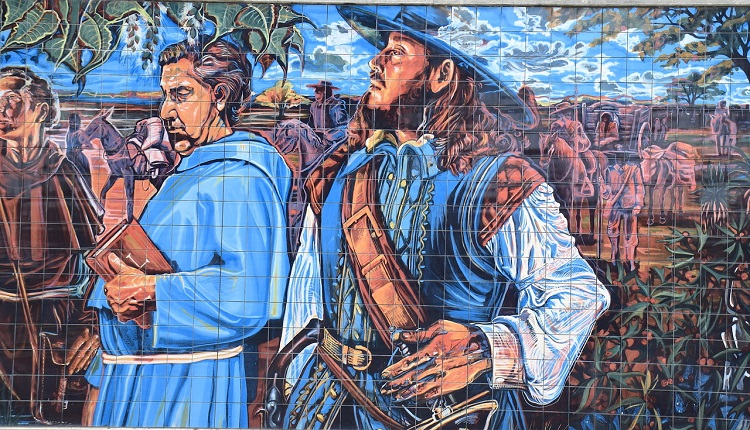By Dr. Ricardo Romo
The Coahuiltecans, the largest Indian group living between the Rio Grande River and the headwaters of the San Antonio River, built the Alamo.
There is no cornerstone or plaque on the Alamo giving them credit for this marvelous construction, but records kept by the Franciscan friars and the military authorities confirm the role of Indian labor in all the missions of Texas.
My Texas history classes in middle school, high school, and at the University of Texas at Austin made no reference to the essential use of Indian labor in constructing San Antonio de Valero [Alamo] or the other four missions in San Antonio. A recent book on San Antonio by Nancy Haston Foster, San Antonio: Lone Star Guides, notes only that “enterprising Spaniards” who camped along the San Antonio River “led to the establishment of five Spanish missions, including the Alamo.”
When the Spanish first traveled through the Central and East Texas region in 1690, they found hundreds of
Payayas living on the banks of San Pedro Springs and the headwaters of the San Antonio River. Initially, it was a desire by the Spanish Crown to lay claim to Texas that brought the Franciscan friars and soldiers to the present-day East Texas region. These friars also founded San Francisco Solano near the Rio Grande [below present-day Eagle Pass in 1700].
When Spanish missionaries encountered failure in the development of missions in East Texas and on the Rio Grande, the Royal Crown gave the Franciscans permission to relocate at least three of the unsuccessful missions to San Antonio. Notable among the missions to be relocated was the mission San Francisco Solano. This mission had not thrived at its original location at San Juan Bautista del Rio Grande [Guerrero, Coahuila] and Franciscans saw new opportunities for it along the banks of the San Antonio River.
Historian Donald E. Chipman commented that “Technically, the new mission [Valero] represented a transfer of Indians from the original San Francisco Solano on the Rio Grande.”
In San Antonio, the Franciscan friars also recruited the local Indian bands, many of them Payayas, to assist in
the building of the Valero Mission and the acequias [irrigation ditches].
One notable Coahuiltecan Indian band, the Xarames, were brought by the Franciscan Father Antonio de San Benaventura Olivares to San Antonio from a mission settlement south of the Rio Grande [Solano Mission] in 1718. The friars brought nearly 100 Xarame Indians for the sole purpose of aiding in the construction of the new San Antonio de Valero Mission in 1718.
The Payayas and Xarames were among the largest bands of the Coahuiltecans, but there were dozens of other clans within a radius of several hundred miles of the San Pedro Springs.
With the exception of some of the Indians leaders referred to as tribal governors or mayordomos, the friars left us with little information concerning the names of the Indian workers who built the Alamo [Valero Mission] and the valuable main irrigation system. To make the farms work, they assigned Indian work teams to dig the irrigation ditches, or acequias, from the headwaters to the Valero mission, a distance of more than five miles. We know that the Indian crops fed the new San Antonio village and contributed to the very survival of the Spanish colonists.
The Spanish friars relied heavily on Indian leaders, such as the Indian governor and Xarame Chief Santiago Ximenes, to help organize the daily labor of the missions which included farming and tending to horses, cattle, sheep, and goats. In his book, With The Makers of San Antonio, author Frederick Chabot noted that Santiago and his brother Nicolas Ximenes were part of the labor force in the construction of San Juan Bautista fifteen years before Valero.
Claudia R. Guerra, author of 300 Years of San Antonio and Bexar County, describes Ximenes’ rise as a “Spanish-Speaking,” Xarame leader who came to San Antonio as “one of the ‘highest chiefs’ among the naciones.” Ximenes arrived at Valero with his wife, Juana Maria, a Payaya Indian and their two year old child. With consultation of the friars, Coahuila Governor Don Martin de Alarcon, appointed Ximenes as Indian governor of Mission San Antonio de Valero.
The Valero church records confirmed the presence of 57 different Indian bands or tribes living in the Valero Mission grounds between the years 1718-1730. Most were from the Coahuiltecan nation, but other tribes such as Apaches came to the mission after 1730. In the case
of Valero Mission, Indian laborers built and rebuilt it, as it was moved three times in the first five years.
San Antonio has monuments to many Mexican and Anglo-Texan heroes, but there are no monuments to the Indian people who occupied the land and headwaters of the city. The Alamo also has the names of many heroes engraved on plaques in different locations, but not a single name of the Indian clans and nations who constructed the structure. This historical neglect should be addressed.
*Special thanks to Ramon Juan Vasquez, Executive Director of the American Indians in Texas at the Spanish Colonial Missions, and Historian Dr. Francisco de la Teja.
*Mural by Adriana Garcia. Commissioned by Bexar County. Special thanks to San Pedro Creek Culture Park. San Antonio, Texas. Cover photo by Ricardo Romo.









